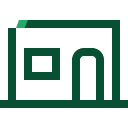
Smart buildings: when buildings think for themselves.
IoT solutions are making buildings more sustainable, more efficient and more pleasant to be in.
Smart buildings are those that have been connected up intelligently and made digital with the aid of IoT technologies. They differ from smart homes in that, in this case, the focus is not on connecting up individual devices but on an integrated digitalization concept that encompasses the monitoring of all aspects of building technology. This involves automating various different functions of a building in order to improve comfort levels, optimise the use of space and cut the consumption of resources such as electricity and water.
This latter aspect in particular has an important role to play, because smart buildings are a way for companies to deliver a significant sustainability boost. And Bechtle can provide you with everything you need for smart buildings. We can help you plan smart building projects from scratch, retrofit existing structures with smart features and support you with scaling up smart building solutions as your rollout partner.

Smart buildings make sustainability reports easier to prepare.
By imposing reporting obligations under the Corporate Sustainability Reporting Directive (CSRD), the EU has introduced mandatory requirements for reporting environmental, social and corporate governance (ESG) information – a tedious and laborious process at best when the data is logged manually. The better way involves sensors, which smart buildings contain in great numbers. These sensors capture relevant data on energy and water consumption, the use of space and other things and thus help simplify the monitoring process. The data can also be harnessed to optimise a building’s features and its consumption of resources.
The benefits of smart buildings include:

Simplified building management
predictive maintenance and precise analyses

Lower resource consumption
and compliance with sustainability targets

Easier preparation of sustainability reports
such as CSRD disclosures

Improved working conditions
thanks to higher comfort levels, e.g. in terms of the indoor climate
Here are a few examples of our smart building solutions:

Smart metering involves intelligent, interconnected meters measuring the consumption of resources such as electricity, water, heating oil and gas. This ensures a high degree of transparency for energy flows, allowing them to be analysed and fine-tuned precisely. Most smart meters use LoRaWAN sensors, which are easy to retrofit, run on batteries (which need changing every 10 years or so) and can transmit data over distances of up to 15 kilometres

Nowadays, many workers split their time between the office and their home. Occupancy sensors allow the capacity utilisation of workstations in buildings to be measured and analysed, furnishing important information for converting individual workstations to a hot-desking arrangement. The sensors also facilitate smart cleaning, where cleaners use an app to see which parts of the building have been used and which have not, enabling them to adjust their cleaning schedules. This saves time, money, water, energy and cleaning products.

Physical keys have a few downsides: they take effort to manage, they can fall into the wrong hands, there is no way of restricting when they can be used, and losing them is extremely irritating. Digital keys, by contrast, which can be issued as transponders or in a smartphone app, are much more convenient. Scanners communicate with the key devices via Bluetooth, NFC or RFID and grant authorised users access to parts of a building, lifts, garages and many other places.

Indoor navigation is all about enabling employees, visitors, maintenance staff or suppliers to find their way around buildings faster, saving them time and thus making them happier. Bluetooth Beacons spread around the building detect people’s positions and communicate with an app on the user’s smartphone. This lets them navigate accurately through office blocks, trade fair halls, shopping centres, airports, hospitals and more.

As well as being important for individual well-being, ensuring a good level of air quality inside a building also plays a key role in curbing the spread of disease. Air quality sensors measure various parameters such as CO2, particulates, temperature and humidity inside individual rooms. If they detect that certain thresholds have been reached there, they send a wireless signal to the building systems. These then make the necessary adjustments to allow fresh air to flow into the room, thus ensuring a consistently high level of air quality inside the building.
Please feel free to get in touch with us if you have any questions or would like an initial no-obligation consultation. We look forward to hearing from you and will get back to you as quickly as possible.
* Mandatory field.
If you’d like to know more about how we handle your personal data, please read our Privacy Policy.
